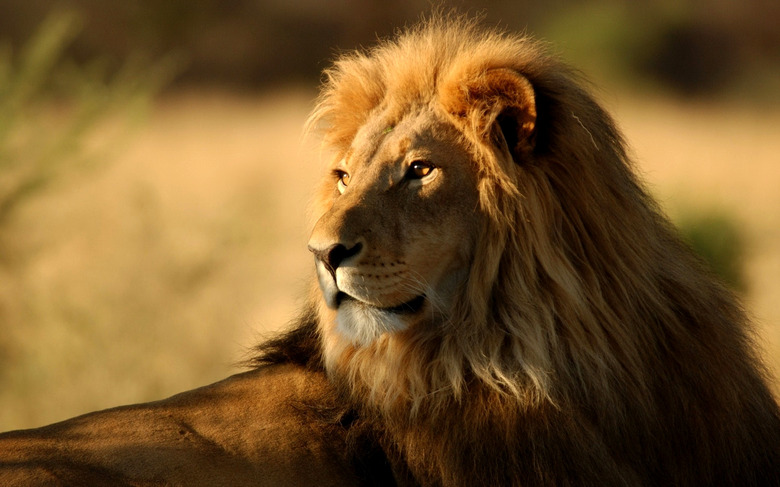How Have Lions Adapted To Their Environment?
As the sun sinks low over the Serengeti, a group of female lions slink through the tall grass while stalking a herd of antelope. They hunt in the dark to stay cool, and they can eat up to 70 pounds of meat in one sitting — an advantage for any carnivore living in an environment as hot and dry as the African savanna. Up to half of all lions live in Tanzania; only a few hundred live outside of Africa, in India's Gir Forest. All lions dwell in harsh environments, and they have adapted to survive.
TL;DR (Too Long; Didn't Read)
Lions have adapted strong, retractable jaws and rough tongues to help them eat their prey, and lions that live in particularly hot environments have adapted to stay cooler in the heat.
General Adaptations
General Adaptations
All lions share certain traits that the species developed in response to environment. Their tan color allows lions to blend in with the savannas, open woodlands and deserts in which they live. Long, retractable claws help lions snare their prey, while rough tongues make it easy for them to peel back the skin of that prey and expose its meat. Lions primarily hunt hoofed animals, such as zebras and wildebeest, so they have developed loose skin on their bellies that protects them from the frantic kicks of their prey.
The Mane Example
The Mane Example
In a given region, the male lion with the largest mane is likely to mate with more females and sire more offspring than his mildly maned counterparts. While it has long been thought that mane characteristics are passed along genetic lines, research has shown that environmental factors, such as local temperature, can influence mane growth. Lions living in colder climates tend to grow fuller, more attractive manes. Lions living in hot climates — such as Tsavo, Kenya — have adapted to grow no manes at all.
Regional Differences
Regional Differences
As with the maneless lions of Tsavo, lions living in desert conditions have adapted to survive this punishing ecosystem. Smaller manes help them stay cool. The lions that prowl Africa's Namib Desert have adapted to breed rapidly and disperse quickly, so that competition for scarce prey resources is reduced. Lions in the Kalahari Desert live in smaller groups and eat smaller prey than their counterparts living in more lush environments. For example, Kalahari lions eat porcupines far more frequently than lions living in other ecosystems.
Continuing to Adapt
Continuing to Adapt
Wild lion populations are plummeting. Conflicts between lions and humans are increasing rapidly as more African villagers take up farming and claim lion habitat as their own. Villagers who once shot only nuisance lions are now poisoning entire prides to ensure the safety of their families. As the African savanna changes, lions' ability to adapt will be challenged. Competition for resources continues to rise, but only time will tell if those females stalking the dark Serengeti will be forced to separate into smaller prides or join forces with other formidable felines in order to survive.
Cite This Article
MLA
Cairoli, Sarah. "How Have Lions Adapted To Their Environment?" sciencing.com, https://www.sciencing.com/lions-adapt-their-environment-4567536/. 19 April 2018.
APA
Cairoli, Sarah. (2018, April 19). How Have Lions Adapted To Their Environment?. sciencing.com. Retrieved from https://www.sciencing.com/lions-adapt-their-environment-4567536/
Chicago
Cairoli, Sarah. How Have Lions Adapted To Their Environment? last modified August 30, 2022. https://www.sciencing.com/lions-adapt-their-environment-4567536/
